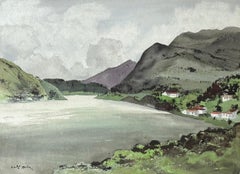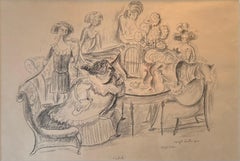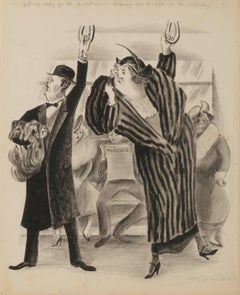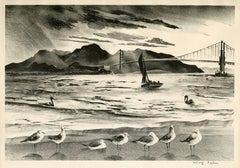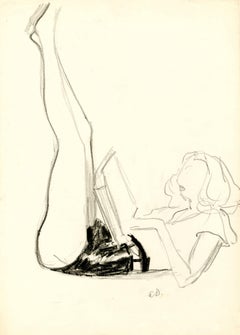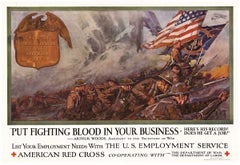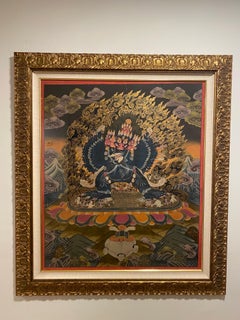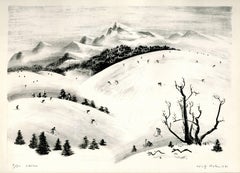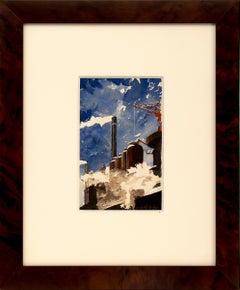Adolf Arthur Dehn Art
American, 1895-1968
Adolf Dehn, printmaker, watercolorist, and illustrator, was born in Waterville, Minnesota, in 1895. In 1914 he began studying at the Minneapolis School of Art, and in 1917, the year his first published drawing appeared in the progressive magazine, The Masses, he received a scholarship to study at the Art Students League in New York. There he worked with Kenneth Hayes Miller and was introduced to lithography by Boardman Robinson.
While in New York, Dehn threw himself into liberal politics. Declaring himself a conscientious objector in 1918, he was forced to spend four months in a Spartanburg, South Carolina, boot camp for refusing to serve in the armed forces and eight months as a volunteer instructor teaching painting and drawing at a hospital for war victims in Asheville, North Carolina.
Dehn spent the years 1920 to 1929 in art-related travel in Europe, primarily in Vienna and in Paris, where he made lithographs at the Atelier Desjobert. Throughout this time, Dehn exhibited his work at the Weyhe Gallery in New York and contributed drawings both to magazines abroad and to the radical journal The Masses.
Upon his return to New York in 1929, he became a leading figure in printmaking circles, exhibiting his prints to considerable critical acclaim. In 1937, Dehn had worked exclusively in black and white until 1937—halfway through his career—when he began to work in watercolor. During his summer visits to Minnesota, he created a large body of regional watercolors depicting the lakes and farms of his home state. Lithography and watercolor remained his two primary media, and his subjects ranged from social satire to naturalistic landscapes.
He authored the treatise, Water Color Painting, in 1945 and two other instructional books on lithography and watercolor in 1950 and 1955. From 1938 to 1939 he taught at Stephens College in Columbia, Missouri, and during the summers of 1940-1942 he taught at the Colorado Springs Fine Arts Center.
In 1939 and 1951 Dehn received Guggenheim Fellowships, and 1961 he was elected Full Academician to the National Academy of Design.
Dehn exhibited throughout his career, and his works are in the permanent collections of the Metropolitan Museum of Art, the Museum of Modern Art, the Art Institute of Chicago, the Museum of Fine Arts in Boston, and the British Museum, among others.
Adolf Dehn died in New York in 1968.to
3
16
5
2
Overall Width
to
Overall Height
to
23
2
6
4
4
1
4
7
1
16
7
11
8
6
5
4
3
3
2
2
2
1
1
1
1
1
1
1
1
1
1
10
4
4
3
3
23
8,777
2,809
1,643
1,319
9
23
Artist: Adolf Arthur Dehn
Near Westport, Ireland”
By Adolf Arthur Dehn
Located in Southampton, NY
Original watercolor on archival paper of a location near Westport, Ireland, most likely Clew Bay by the very well known American artist, Adolf Arthur Dehn. Signed by the artist low...
Category
1960s American Realist Adolf Arthur Dehn Art
Materials
Watercolor, Archival Paper
$2,880 Sale Price
20% Off
“5 O’Clock”
By Adolf Arthur Dehn
Located in Southampton, NY
.
Here for your consideration is an original signed lithograph by Adolf Arthur Dehn done in 1922 titled 5 O’Clock. The condition of the lithograph is excellent.
Signed in the p...
Category
1920s Post-War Adolf Arthur Dehn Art
Materials
Archival Paper, Lithograph
$1,280 Sale Price
20% Off
Adolf Dehn 1940s Kresge's at Christmas Time
By Adolf Arthur Dehn
Located in San Francisco, CA
Adolf Dehn: 1895-1968. Well listed American artist with a high auction record of $20,000 which was achieved this year. He was born in Minnesota and studied at Minneapolis School of F...
Category
1940s Adolf Arthur Dehn Art
Materials
Mixed Media
Getting Ready for the Revolution - Learning How to Ride in the Subway
By Adolf Arthur Dehn
Located in Fairlawn, OH
Getting Ready for the Revolution - Learning How to Ride in the Subway
Litho crayons on illustrator’s board, c. 1932
Signed: Adolf Dehn (VED) lower right corner (signed by Virginia Dehn, the artist’s widow)
Tilted along the upper edge of the recto in pencil by the artist
Verso inscriptions: “VF 3168.D” in a circle, also annotated in red pencil “32” in a circle and “699
Provenance:
Mary Ryan Gallery, exhibition entitled Adolf Dehn Lithographs, 1927-1940, Nov. 16 to Dec. 12, 1982. The original exhibition notice us affixed to the backing board of the frame
Note: A drawing intended or used in the publication Vanity Fair, for whom Dehn worked in the mid 1920’s to the 1930’s.
Adolf Dehn, American Watercolorist and Printmaker, 1895-1968
Adolf Dehn was an artist who achieved extraordinary artistic heights, but in a very particular artistic sphere—not so much in oil painting as in watercolor and lithography. Long recognized as a master by serious print collectors, he is gradually gaining recognition as a notable and influential figure in the overall history of American art.
In the 19th century, with the invention of the rotary press, which made possible enormous print runs, and the development of the popular, mass-market magazines, newspaper and magazine illustration developed into an artistic realm of its own, often surprisingly divorced from the world of museums and art exhibitions, and today remains surprisingly overlooked by most art historians. Dehn in many regards was an outgrowth of this world, although in an unusual way, since as a young man he produced most of his illustrative work not for popular magazines, such as The Saturday Evening Post, but rather for radical journals, such as The Masses or The Liberator, or artistic “little magazines” such as The Dial. This background established the foundation of his outlook, and led later to his unique and distinctive contribution to American graphic art.
If there’s a distinctive quality to his work, it was his skill in introducing unusual tonal and textural effects into his work, particularly in printmaking but also in watercolor. Jackson Pollock seems to have been one of many notable artists who were influenced by his techniques.
Early Years, 1895-1922
For an artist largely remembered for scenes of Vienna and Paris, Adolf Dehn’s background was a surprising one. Born in Waterville, Minnesota, on November 22, 1895, Dehn was the descendent of farmers who had emigrated from Germany and homesteaded in the region, initially in a one-room log cabin with a dirt floor. Adolf’s father, Arthur Clark Dehn, was a hunter and trapper who took pride that he had no boss but himself, and who had little use for art. Indeed, during Adolf’s boyhood the walls of his bedroom and the space under his bed were filled with the pelts of mink, muskrats and skunks that his father had killed, skinned and stretched on drying boards. It was Adolf’s mother, Emilie Haas Dehn, a faithful member of the German Lutheran Evangelical Church, who encouraged his interest in art, which became apparent early in childhood. Both parents were ardent socialists, and supporters of Eugene Debs...
Category
1930s American Modern Adolf Arthur Dehn Art
Materials
Oil Crayon
The Golden Gate
By Adolf Arthur Dehn
Located in Fairlawn, OH
The Golden Gate
Lithograph on wove paper watermarked GC, 1940
Signed in pencil by the artist (see photo)
Publisher: Associated American Artists
Edition: 189, unnumbered
The image depicts The Golden Gate Bridge which connects San Francisco and Marin County, California
References And Exhibitions:
Illustrated: Adams, The Sensuous Life of Adolf Dehn, Fig. 13.17, page 324
Reference: L & O 325
AAA Index 391
Adolf Dehn, American Watercolorist and Printmaker, 1895-1968
Adolf Dehn was an artist who achieved extraordinary artistic heights, but in a very particular artistic sphere—not so much in oil painting as in watercolor and lithography. Long recognized as a master by serious print collectors, he is gradually gaining recognition as a notable and influential figure in the overall history of American art.
In the 19th century, with the invention of the rotary press, which made possible enormous print runs, and the development of the popular, mass-market magazines, newspaper and magazine illustration developed into an artistic realm of its own, often surprisingly divorced from the world of museums and art exhibitions, and today remains surprisingly overlooked by most art historians. Dehn in many regards was an outgrowth of this world, although in an unusual way, since as a young man he produced most of his illustrative work not for popular magazines, such as The Saturday Evening Post, but rather for radical journals, such as The Masses or The Liberator, or artistic “little magazines” such as The Dial. This background established the foundation of his outlook, and led later to his unique and distinctive contribution to American graphic art.
If there’s a distinctive quality to his work, it was his skill in introducing unusual tonal and textural effects into his work, particularly in printmaking but also in watercolor. Jackson Pollock seems to have been one of many notable artists who were influenced by his techniques.
Early Years, 1895-1922
For an artist largely remembered for scenes of Vienna and Paris, Adolf Dehn’s background was a surprising one. Born in Waterville, Minnesota, on November 22, 1895, Dehn was the descendent of farmers who had emigrated from Germany and homesteaded in the region, initially in a one-room log cabin with a dirt floor. Adolf’s father, Arthur Clark Dehn, was a hunter and trapper who took pride that he had no boss but himself, and who had little use for art. Indeed, during Adolf’s boyhood the walls of his bedroom and the space under his bed were filled with the pelts of mink, muskrats and skunks that his father had killed, skinned and stretched on drying boards. It was Adolf’s mother, Emilie Haas Dehn, a faithful member of the German Lutheran Evangelical Church, who encouraged his interest in art, which became apparent early in childhood. Both parents were ardent socialists, and supporters of Eugene Debs. In many ways Dehn’s later artistic achievement was clearly a reaction against the grinding rural poverty of his childhood.
After graduating from high school in 1914 at the age of 19—an age not unusual in farming communities at the time, where school attendance was often irregular—Dehn attended the Minneapolis School of Art from 1914 to 1917, whose character followed strongly reflected that of its director, Munich-trained Robert Kohler, an artistic conservative but a social radical. There Dehn joined a group of students who went on to nationally significant careers, including Wanda Gag (later author of best-selling children’s books); John Flanagan (a sculptor notable for his use of direct carving) Harry Gottlieb (a notable social realist and member of the Woodstock Art Colony), Elizabeth Olds (a printmaker and administrator for the WPA), Arnold Blanch (landscape, still-life and figure painter, and member of the Woodstock group), Lucille Lunquist, later Lucille Blanch (also a gifted painter and founder of the Woodstock art colony), and Johan Egilrud (who stayed in Minneapolis and became a journalist and poet).
Adolf became particularly close to Wanda Gag (1893-1946), with whom he established an intense but platonic relationship. Two years older than he, Gag was the daughter of a Bohemian artist and decorator, Anton Gag, who had died in 1908. After her husband died, Wanda’s mother, Lizzi Gag, became a helpless invalid, so Wanda was entrusted with the task of raising and financially supporting her six younger siblings. This endowed her with toughness and an independent streak, but nonetheless, when she met Dehn, Wanda was Victorian and conventional in her artistic taste and social values. Dehn was more socially radical, and introduced her to radical ideas about politics and free love, as well as to socialist publications such as The Masses and The Appeal to Reason.
Never very interested in oil painting, in Minneapolis Dehn focused on caricature and illustration--often of a humorous or politically radical character. In 1917 both Dehn and Wanda won scholarships to attend the Art Students League, and consequently, in the fall of that year both moved to New York. Dehn’s art education, however, ended in the summer of 1918, shortly after the United States entered World War I, when he was drafted to serve in the U. S. Army. Unwilling to fight, he applied for status as a conscientious objector, but was first imprisoned, then segregated in semi-imprisonment with other Pacifists, until the war ended. The abuse he suffered at this time may well explain his later withdrawal from taking political stands or making art of an overtly political nature. After his release from the army, Dehn returned to New York where he fell under the spell of the radical cartoonist Boardman Robinson and produced his first lithographs. He also finally consummated his sexual relationship with Wanda Gag.
The Years in Europe: 1922-1929
In September of 1921, however, he abruptly departed for Europe, arriving in Paris and then moving on to Vienna. There in the winter of 1922 he fell in love with a Russian dancer, Mura Zipperovitch, ending his seven-year relationship with Wanda Gag. He and Mura were married in 1926. It was also in Vienna that he produced his first notable artistic work.
Influenced by European artists such as Jules Pascin and Georg Grosz, Dehn began producing drawings of people in cafes, streets, and parks, which while mostly executed in his studio, were based on spontaneous life studies and have an expressive, sometimes almost childishly wandering quality of line. The mixture of sophistication and naiveté in these drawings was new to American audiences, as was the raciness of their subject matter, which often featured pleasure-seekers, prostitutes or scenes of sexual dalliance, presented with a strong element of caricature. Some of these drawings contain an element of social criticism, reminiscent of that found in the work of George Grosz, although Dehn’s work tended to focus on humorous commentary rather than savagely attacking his subjects or making a partisan political statement. Many Americans, including some who had originally been supporters of Dehn such as Boardman Robinson, were shocked by these European drawings, although George Grocz (who became a friend of the artist in this period) admired them, and recognized that Dehn could also bring a new vision to America subject matter. As he told Dehn: “You will do things in America which haven’t been done, which need to be done, which only you can do—as far at least as I know America.”
A key factor in Dehn’s artistic evolution at this time was his association with Scofield Thayer...
Category
1940s American Realist Adolf Arthur Dehn Art
Materials
Lithograph
Eileen Lake
By Adolf Arthur Dehn
Located in Fairlawn, OH
Eileen Lake
Crayon on paper, early1930's
Initialed in pencil lower right (see photo)
Titled and annotated verso "Eileen Lake, early 1930s girlfriend"
Note: Eileen Hall Lake was an American poet and Adolf Dehn's girlfriend in the early 1930s.
Provenance:
Estate of the artist
By descent
Adolf Dehn, American Watercolorist and Printmaker, 1895-1968
Adolf Dehn was an artist who achieved extraordinary artistic heights, but in a very particular artistic sphere—not so much in oil painting as in watercolor and lithography. Long recognized as a master by serious print collectors, he is gradually gaining recognition as a notable and influential figure in the overall history of American art.
In the 19th century, with the invention of the rotary press, which made possible enormous print runs, and the development of the popular, mass-market magazines, newspaper and magazine illustration developed into an artistic realm of its own, often surprisingly divorced from the world of museums and art exhibitions, and today remains surprisingly overlooked by most art historians. Dehn in many regards was an outgrowth of this world, although in an unusual way, since as a young man he produced most of his illustrative work not for popular magazines, such as The Saturday Evening Post, but rather for radical journals, such as The Masses or The Liberator, or artistic “little magazines” such as The Dial. This background established the foundation of his outlook, and led later to his unique and distinctive contribution to American graphic art.
If there’s a distinctive quality to his work, it was his skill in introducing unusual tonal and textural effects into his work, particularly in printmaking but also in watercolor. Jackson Pollock seems to have been one of many notable artists who were influenced by his techniques.
Early Years, 1895-1922
For an artist largely remembered for scenes of Vienna and Paris, Adolf Dehn’s background was a surprising one. Born in Waterville, Minnesota, on November 22, 1895, Dehn was the descendent of farmers who had emigrated from Germany and homesteaded in the region, initially in a one-room log cabin with a dirt floor. Adolf’s father, Arthur Clark Dehn, was a hunter and trapper who took pride that he had no boss but himself, and who had little use for art. Indeed, during Adolf’s boyhood the walls of his bedroom and the space under his bed were filled with the pelts of mink, muskrats and skunks that his father had killed, skinned and stretched on drying boards. It was Adolf’s mother, Emilie Haas Dehn, a faithful member of the German Lutheran Evangelical Church, who encouraged his interest in art, which became apparent early in childhood. Both parents were ardent socialists, and supporters of Eugene Debs. In many ways Dehn’s later artistic achievement was clearly a reaction against the grinding rural poverty of his childhood.
After graduating from high school in 1914 at the age of 19—an age not unusual in farming communities at the time, where school attendance was often irregular—Dehn attended the Minneapolis School of Art from 1914 to 1917, whose character followed strongly reflected that of its director, Munich-trained Robert Kohler, an artistic conservative but a social radical. There Dehn joined a group of students who went on to nationally significant careers, including Wanda Gag (later author of best-selling children’s books); John Flanagan (a sculptor notable for his use of direct carving) Harry Gottlieb (a notable social realist and member of the Woodstock Art Colony), Elizabeth Olds (a printmaker and administrator for the WPA), Arnold Blanch (landscape, still-life and figure painter, and member of the Woodstock group), Lucille Lunquist, later Lucille Blanch (also a gifted painter and founder of the Woodstock art colony), and Johan Egilrud (who stayed in Minneapolis and became a journalist and poet).
Adolf became particularly close to Wanda Gag (1893-1946), with whom he established an intense but platonic relationship. Two years older than he, Gag was the daughter of a Bohemian artist and decorator, Anton Gag, who had died in 1908. After her husband died, Wanda’s mother, Lizzi Gag, became a helpless invalid, so Wanda was entrusted with the task of raising and financially supporting her six younger siblings. This endowed her with toughness and an independent streak, but nonetheless, when she met Dehn, Wanda was Victorian and conventional in her artistic taste and social values. Dehn was more socially radical, and introduced her to radical ideas about politics and free love, as well as to socialist publications such as The Masses and The Appeal to Reason.
Never very interested in oil painting, in Minneapolis Dehn focused on caricature and illustration--often of a humorous or politically radical character. In 1917 both Dehn and Wanda won scholarships to attend the Art Students League, and consequently, in the fall of that year both moved to New York. Dehn’s art education, however, ended in the summer of 1918, shortly after the United States entered World War I, when he was drafted to serve in the U. S. Army. Unwilling to fight, he applied for status as a conscientious objector, but was first imprisoned, then segregated in semi-imprisonment with other Pacifists, until the war ended. The abuse he suffered at this time may well explain his later withdrawal from taking political stands or making art of an overtly political nature. After his release from the army, Dehn returned to New York where he fell under the spell of the radical cartoonist Boardman Robinson and produced his first lithographs. He also finally consummated his sexual relationship with Wanda Gag.
The Years in Europe: 1922-1929
In September of 1921, however, he abruptly departed for Europe, arriving in Paris and then moving on to Vienna. There in the winter of 1922 he fell in love with a Russian dancer, Mura Zipperovitch, ending his seven-year relationship with Wanda Gag. He and Mura were married in 1926. It was also in Vienna that he produced his first notable artistic work.
Influenced by European artists such as Jules Pascin and Georg Grosz, Dehn began producing drawings of people in cafes, streets, and parks, which while mostly executed in his studio, were based on spontaneous life studies and have an expressive, sometimes almost childishly wandering quality of line. The mixture of sophistication and naiveté in these drawings was new to American audiences, as was the raciness of their subject matter, which often featured pleasure-seekers, prostitutes or scenes of sexual dalliance, presented with a strong element of caricature. Some of these drawings contain an element of social criticism, reminiscent of that found in the work of George Grosz, although Dehn’s work tended to focus on humorous commentary rather than savagely attacking his subjects or making a partisan political statement. Many Americans, including some who had originally been supporters of Dehn such as Boardman Robinson, were shocked by these European drawings, although George Grocz (who became a friend of the artist in this period) admired them, and recognized that Dehn could also bring a new vision to America subject matter. As he told Dehn: “You will do things in America which haven’t been done, which need to be done, which only you can do—as far at least as I know America.”
A key factor in Dehn’s artistic evolution at this time was his association with Scofield Thayer...
Category
1930s American Realist Adolf Arthur Dehn Art
Materials
Oil Crayon
Adolf Dehn, Haitian Scene A, signed painting, Associated American Artists, 1950s
By Adolf Arthur Dehn
Located in New York, NY
Adolf Arthur Dehn
Haitian Scene A, ca. 1951
Watercolor gouache on board
Signed on the front
Frame included: held in vintage modern frame
Measurements:
Framed:
11 inches vertical by 13 inches horizontal by .75
Painting
4.5 inches by 6 inches
Watercolor gouache, hand signed; framed with AAA Gallery label verso
Signed on the front bearing the original label on the verso of Dehn's longtime gallery, the prestigious Associated American Artists Gallery, New York City.
Provenance
Associated American Artists
Frame included: held in vintage frame with original label as provenance
Dehn, an influential artist and teacher (and author of the definitive textbook of his era on watercolor painting) joined Associated American Artists gallery in 1941. Although this painting is undated, it is likely circa early 1950s, as in 1951 Dehn won a Guggenheim Fellowship, which enabled him to travel to Haiti -- the subject of this work. It was part of a series inspired by Dehn's visit to Haiti.
Dehn, an influential artist and teacher (and author of the definitive textbook of his era on watercolor painting) joined Associated American Artists gallery in 1941. Although this painting is undated, it is likely circa early 1950s, as in 1951 Dehn won a Guggenheim Fellowship, which enabled him to travel to Haiti.
ADLOF DEHN
Adolf Dehn, American Watercolorist and Printmaker, 1895-1968
Adolf Dehn was an artist who achieved extraordinary artistic heights, but in a very particular artistic sphere - not so much in oil painting as in watercolor and lithography. Long recognized as a master by serious print collectors, he is gradually gaining recognition as a notable and influential figure in the overall history of American art.
In the 19th century, with the invention of the rotary press, which made possible enormous print runs, and the development of the popular, mass-market magazines, newspaper and magazine illustration developed into an artistic realm of its own, often surprisingly divorced from the world of museums and art exhibitions, and today remains surprisingly overlooked by most art historians. Dehn in many regards was an outgrowth of this world, although in an unusual way, since as a young man he produced most of his illustrative work not for popular magazines, such as The Saturday Evening Post, but rather for radical journals, such as The Masses or The Liberator, or artistic "little magazines" such as The Dial. This background established the foundation of his outlook, and led later to his unique and distinctive contribution to American graphic art.
If there’s a distinctive quality to his work, it was his skill in introducing unusual tonal and textural effects into his work, particularly in printmaking but also in watercolor. Jackson Pollock seems to have been one of many notable artists who were influenced by his techniques.
Early Years, 1895 - 1922
For an artist largely remembered for scenes of Vienna and Paris, Adolf Dehn’s background was a surprising one. Born in Waterville, Minnesota, on November 22, 1895, Dehn was the descendent of farmers who had emigrated from Germany and homesteaded in the region, initially in a one-room log cabin with a dirt floor. Adolf’s father, Arthur Clark Dehn, was a hunter and trapper who took pride that he had no boss but himself, and who had little use for art. Indeed, during Adolf’s boyhood the walls of his bedroom and the space under his bed were filled with the pelts of mink, muskrats and skunks that his father had killed, skinned and stretched on drying boards. It was Adolf’s mother, Emilie Haas Dehn, a faithful member of the German Lutheran Evangelical Church, who encouraged his interest in art, which became apparent early in childhood. Both parents were ardent socialists, and supporters of Eugene Debs...
Category
1950s Modern Adolf Arthur Dehn Art
Materials
Watercolor, Gouache, Board
Brooklyn Waterfront
By Adolf Arthur Dehn
Located in Fairlawn, OH
Brooklyn Waterfront
Lithograph, 1931
Signed, titled, and dated in pencil by the artist
Edition: Undetermined (very small), plus artist's proofs
Printed by Meister Schulz, Berlin
Provenance:
Estate of the artist
Virginia Dehn, the artist's widow
Dehn Quests
Bibliography:
Lumsdaine and O'Sullivan 152
Illustrated: Adams, The Sensuous Life of Adolf Dehn, Fig. 9.14, page 213 (This impression)
Adolf Dehn, American Watercolorist and Printmaker, 1895-1968
Adolf Dehn was an artist who achieved extraordinary artistic heights, but in a very particular artistic sphere—not so much in oil painting as in watercolor and lithography. Long recognized as a master by serious print collectors, he is gradually gaining recognition as a notable and influential figure in the overall history of American art.
In the 19th century, with the invention of the rotary press, which made possible enormous print runs, and the development of the popular, mass-market magazines, newspaper and magazine illustration developed into an artistic realm of its own, often surprisingly divorced from the world of museums and art exhibitions, and today remains surprisingly overlooked by most art historians. Dehn in many regards was an outgrowth of this world, although in an unusual way, since as a young man he produced most of his illustrative work not for popular magazines, such as The Saturday Evening Post, but rather for radical journals, such as The Masses or The Liberator, or artistic “little magazines” such as The Dial. This background established the foundation of his outlook, and led later to his unique and distinctive contribution to American graphic art.
If there’s a distinctive quality to his work, it was his skill in introducing unusual tonal and textural effects into his work, particularly in printmaking but also in watercolor. Jackson Pollock seems to have been one of many notable artists who were influenced by his techniques.
Early Years, 1895-1922
For an artist largely remembered for scenes of Vienna and Paris, Adolf Dehn’s background was a surprising one. Born in Waterville, Minnesota, on November 22, 1895, Dehn was the descendent of farmers who had emigrated from Germany and homesteaded in the region, initially in a one-room log cabin with a dirt floor. Adolf’s father, Arthur Clark Dehn, was a hunter and trapper who took pride that he had no boss but himself, and who had little use for art. Indeed, during Adolf’s boyhood the walls of his bedroom and the space under his bed were filled with the pelts of mink, muskrats and skunks that his father had killed, skinned and stretched on drying boards. It was Adolf’s mother, Emilie Haas Dehn, a faithful member of the German Lutheran Evangelical Church, who encouraged his interest in art, which became apparent early in childhood. Both parents were ardent socialists, and supporters of Eugene Debs...
Category
1920s American Modern Adolf Arthur Dehn Art
Materials
Lithograph
Jersey Shore III
By Adolf Arthur Dehn
Located in Fairlawn, OH
Jersey Shore III
Casein on Masonite, 1967
Signed lower right (see photo)
Initialed, dated and titled verso
Provenance:
Estate of the artist
Virginia Dehn (the artist's widow)
Dehn Qu...
Category
1960s American Modern Adolf Arthur Dehn Art
Materials
Oil
Jersey Shore III
By Adolf Arthur Dehn
Located in Fairlawn, OH
Jersey Shore III
Casein on Masonite, 1967
Signed lower right (see photo)
Initialed, dated and titled verso
Provenance:
Estate of the artist
Virginia Dehn (the artist's widow)
Dehn Quests
Created on location on the Jersey Shore. The Jersey Shore was the main playground for thousand to escape the summer heat of New York. This small painting shows Dehn's mastery of patterning color to depict movement and recreation. Part of a suite of paintings done on this theme. Within a year of it's creation, Dehn dies from a heart attack.
Casein on Masonite
Condition: Excellent
Image: 6 x 11"
Frame: 9 3/8 x 14 1/2"
Adolf Dehn, American Watercolorist and Printmaker, 1895-1968
Adolf Dehn was an artist who achieved extraordinary artistic heights, but in a very particular artistic sphere—not so much in oil painting as in watercolor and lithography. Long recognized as a master by serious print collectors, he is gradually gaining recognition as a notable and influential figure in the overall history of American art.
In the 19th century, with the invention of the rotary press, which made possible enormous print runs, and the development of the popular, mass-market magazines, newspaper and magazine illustration developed into an artistic realm of its own, often surprisingly divorced from the world of museums and art exhibitions, and today remains surprisingly overlooked by most art historians. Dehn in many regards was an outgrowth of this world, although in an unusual way, since as a young man he produced most of his illustrative work not for popular magazines, such as The Saturday Evening Post, but rather for radical journals, such as The Masses or The Liberator, or artistic “little magazines” such as The Dial. This background established the foundation of his outlook, and led later to his unique and distinctive contribution to American graphic art.
If there’s a distinctive quality to his work, it was his skill in introducing unusual tonal and textural effects into his work, particularly in printmaking but also in watercolor. Jackson Pollock seems to have been one of many notable artists who were influenced by his techniques.
Early Years, 1895-1922
For an artist largely remembered for scenes of Vienna and Paris, Adolf Dehn’s background was a surprising one. Born in Waterville, Minnesota, on November 22, 1895, Dehn was the descendent of farmers who had emigrated from Germany and homesteaded in the region, initially in a one-room log cabin with a dirt floor. Adolf’s father, Arthur Clark Dehn, was a hunter and trapper who took pride that he had no boss but himself, and who had little use for art. Indeed, during Adolf’s boyhood the walls of his bedroom and the space under his bed were filled with the pelts of mink, muskrats and skunks that his father had killed, skinned and stretched on drying boards. It was Adolf’s mother, Emilie Haas Dehn, a faithful member of the German Lutheran Evangelical Church, who encouraged his interest in art, which became apparent early in childhood. Both parents were ardent socialists, and supporters of Eugene Debs...
Category
1960s American Modern Adolf Arthur Dehn Art
Materials
Oil
Key West Beach
By Adolf Arthur Dehn
Located in San Francisco, CA
This artwork titled "Key West Beach" 1947 is an original lithograph on paper by noted American artist Adolf Arthur Dehn, 1895-1968. It is hand signed in penci...
Category
Mid-20th Century American Realist Adolf Arthur Dehn Art
Materials
Lithograph
Story of a Farm Girl Adolf Dehn original lithograph 1945 signed by artist pencil
By Adolf Arthur Dehn
Located in Paonia, CO
Adolf Dehn (1895 -1968 )
Story of a Farm Girl
original lithograph
published Lawrence Barrett 1945
handmade paper
paper 15.50 x 12
image 13.75 x 11
signed and titled by the artist in...
Category
1940s Adolf Arthur Dehn Art
Materials
Lithograph
Innocence in Venice
By Adolf Arthur Dehn
Located in Fairlawn, OH
Signed, dated, titled and annotated "100 prints" in pencil by the artist
Edition: 100
Printed by George Miller, New York
This lithograph was a selection of the Adolf Dehn Pr...
Category
1930s Adolf Arthur Dehn Art
Materials
Lithograph
Cornucopia
By Adolf Arthur Dehn
Located in Fairlawn, OH
Signed by the artist in ink lower right
Preliminary sketch in reverse for the 1928 lithograph "Cornucopia," part of Dehn's Paris Lithographs portfolio
An unsigned sketch of tw...
Category
1920s Adolf Arthur Dehn Art
Materials
Ink
Niagara Falls
By Adolf Arthur Dehn
Located in Fairlawn, OH
Niagara Falls
Lithograph, 1931
Signed lower right (see photo)
Titled/edition lower left. (see photo)
Edition of 25
Provenance: the Estate of the Artist
Condition: Excellent
Image si...
Category
1930s American Modern Adolf Arthur Dehn Art
Materials
Lithograph
“Aiguebelette, Savoie”
By Adolf Arthur Dehn
Located in Southampton, NY
Original early modernist india ink drawing with brushwork by the well known American artist, Adolf Arthur Dehn. Signed by the artist, titled and dated 1925 lower right. Dehn spent his early career traveling and working in Europe during the three year time period 1922 to 1925 when this drawing was done in France. The Chateau d’Auguebelette build in the fourteen century as a fort sits high on the mountain range to the left. Condition is very good. Light toning of paper consistent with age. Under glass, not examined out of frame. The artwork is housed in a antique style silver leaf contemporary frame 16.25 by 22 inches.
Adolf Dehn, painter, printmaker, author, illustrator and teacher, was born Adolph Arthur Dehn in Waterville, Minnesota on November 22, 1895. He was valedictorian of his graduating class at Waterville High School and attended the Minneapolis School of Art between 1914 and 1917. Dehn studied for a year at the Art Students League in New York beginning in 1919. While in New York he met Boardman Robinson who introduced him to the master printer, George Miller. The first exhibition of Dehn's lithographs was held at the Weyhe Gallery in New York City in 1921 and the Weyhe Gallery mounted his first solo exhibition in 1923.
Throughout is life Dehn was a frequent visitor to Europe, staying for various periods of time. Upon his return from a three-year stay in Europe in 1925, he changed the spelling of his first name to Adolf.
In 1934, Dehn established the Adolf Dehn Print Club and was one of the founder-member artists of Associated American Artists in New York. He was selected by Prints magazine as one of the ten best printmakers in the United States in 1936 and the following year he worked in the graphic arts division of the Federal Art Project. He taught summers at Stephens College in Columbia, Missouri (1938) and the Colorado Springs Fine Arts Center (1940-1942).
For his lithographs, Dehn worked with the finest printers including Meister Schulz in Berlin, Edmond Desjobert in Paris, and George Miller, Grant Arnold...
Category
1920s Modern Adolf Arthur Dehn Art
Materials
India Ink, Archival Paper
$2,400 Sale Price
25% Off
Believe in Jesus and be saved from everlasting Hell
By Adolf Arthur Dehn
Located in Fairlawn, OH
Signed and dated lower right
Provenance:
Estate of the artist
Ink on paper
Category
1920s Adolf Arthur Dehn Art
Materials
India Ink
Snow Mountain (or Lake in the Mountains)
By Adolf Arthur Dehn
Located in Fairlawn, OH
Signed lower right
Edition: Undetermined, plus an artist's edition of 10
Edition: Undetermined, plus an artist's edition of 10
Published by the Associated American Artist
...
Category
1960s Adolf Arthur Dehn Art
Materials
Lithograph
That Pig of A Morin Adolf Dehn 1945 lithograph from Tales of Guy de Maupassant
By Adolf Arthur Dehn
Located in Paonia, CO
Adolf Dehn
That Pig of A Morin
original lithograph
published Lawrence Barrett 1945
handmade paper
15.50 x 12
signed and titled in pencil by artist
That Pig of a Morin is from a portfolio of 20 lithographs “Selected Tales of Guy de Maupassant...
Category
1940s Adolf Arthur Dehn Art
Materials
Lithograph
Maroon Lake, Colorado
By Adolf Arthur Dehn
Located in San Francisco, CA
This artwork titled "Maroon Lake, Colorado" 1945 is an original lithograph on paper by noted American artist Adolf Arthur Dehn, 1895-1968. It is hand signed, dated, titled, numbered ...
Category
Mid-20th Century American Realist Adolf Arthur Dehn Art
Materials
Lithograph
Chicago Skyline
By Adolf Arthur Dehn
Located in Fairlawn, OH
Unsigned
Provenance:
Estate of the artist
c. 1929/30
Sheet: 9 7/8 x 14 1/8"
Mat: 15 1/4 x 19 3/4"
Category
1920s Adolf Arthur Dehn Art
Materials
Oil Crayon
untitled (Lesson 3)
By Adolf Arthur Dehn
Located in Fairlawn, OH
Signed and dated by the artist in ink, lower right
Annotated in ink lower left: 3.
Plate 15. - Lesson 3
A very early student work.
From the Artist's estate
Category
1910s Adolf Arthur Dehn Art
Materials
Ink
Joseph Pennell
By Adolf Arthur Dehn
Located in Fairlawn, OH
Signed and dated in pencil verso
Titled "Joseph Pennell" recto
Annotated verso:
Adolph a Dehn
Oct. 5 1915
Tonight I saw a duplicate of Whistler -- "Joseph Pennell." Bu...
Category
1910s Adolf Arthur Dehn Art
Materials
Graphite
Related Items
Put Fighting Blood in Your Business
Located in Spokane, WA
Original WW1 poster. Put Fighting Blood in Your Business. Here’s his record! Does he get a Job? Arthur Woods, Assistant to the Secretary of...
Category
1910s American Realist Adolf Arthur Dehn Art
Materials
Lithograph
Framed Hand Painted Vajrapani Thangka on Canvas 24K Gold
Located in TRUMBULL, CT
This professionally framed "Vajrapani" thangka is hand painted on canvas with 24K real gold.
Shimmering gold brush strokes and dark color palette with illustrative work framed in an...
Category
1980s Other Art Style Adolf Arthur Dehn Art
Materials
Mixed Media
$2,437 Sale Price
35% Off
H 41.5 in W 36.5 in D 1.5 in
Hand Painted Jambhala or Kuber Thangka on Canvas with 24K Real Gold
Located in TRUMBULL, CT
This is a framed, hand painted thangka of Jambhala or Kubera on canvas with 24 carat gold.
Jambhala is seated in easy pose with one hand holding a jewel and another a mongoose. Jambhala is also known as Kubera or Vaishravana, the deity of wealth. He has a protruding belly who wears five lobed crown and serpent jewelry...
Category
Late 20th Century Other Art Style Adolf Arthur Dehn Art
Materials
Mixed Media
$280 Sale Price
20% Off
H 19.5 in W 15.5 in
Adonis, pastel drawing on oversize black paper, muscular male nude
By Audrey Anastasi
Located in Brooklyn, NY
These recently discovered 1983-84 oversize pastels on archival papers were created working quickly, in pastel. The series shows the last existing obs...
Category
2010s American Modern Adolf Arthur Dehn Art
Materials
Pastel, Mixed Media, Archival Paper
$1,800
H 40 in W 32 in D 0.1 in
Grace Martin Taylor (Frame), (Town View), 1930, pastel, signed
Located in New York, NY
West Virginia native Grace Martin Taylor, artist for the brightly colored pastel (TownView), attended the Pennsylvania Academy of Fine Arts and the Art S...
Category
1930s American Modern Adolf Arthur Dehn Art
Materials
Pastel
Original Remember Your First Thrill of American Liberty 1917 vintage poster
Located in Spokane, WA
Original poster: Rembember Your First Thrill of Ameridan Liberty YOUR DUTY Buy United States Government Bonds 2nd Liberty Loan of 1917. Linen backed and ready to frame. Poste...
Category
1910s American Realist Adolf Arthur Dehn Art
Materials
Lithograph
$650
H 30 in W 20 in D 0.2 in
French Mid-Century 1950s Mens Fashion Design Vintage Suit Lithograph Print
Located in Melbourne, Victoria
French men's fashion design from 'La Revue de l'Homme' a Parisien fashion periodical.
370mm by 270mm (sheet)
Category
Mid-20th Century Post-War Adolf Arthur Dehn Art
Materials
Lithograph
$80
H 14.57 in W 10.63 in
Police Line, New York City - Photorealist Watercolor by Don David
By Don David
Located in Long Island City, NY
Artist: Don Davis
Title: Police Line
Medium: Watercolor on paper, signed lower right
Image Size: 18 x 24 inches
Frame Size: 24.5 x 30.25 inches
The viewer is at the edge of the acti...
Category
1980s American Realist Adolf Arthur Dehn Art
Materials
Watercolor, Archival Paper
$2,150
H 24.5 in W 30.25 in
Ann Nooney, (Demolition with Windows, NYC)
By Ann Nooney
Located in New York, NY
The dimensions are for the image; there are large margins. This lithograph is signed in pencil.
A native New Yorker, Ann Nooney (1900-1970) recorded the urban scene while on the Wo...
Category
1930s American Realist Adolf Arthur Dehn Art
Materials
Lithograph
Original 'The Evergreen Playground' Easter Washington State map
Located in Spokane, WA
Original The Evergreen Playground Kroll Map Company vintage poster. Archival linen backed in fine condition. A- condition with only 1 small repair on the outer border in the white area. No tears nor stains.
This map was originally drawn during the Great Depression by Ed Poland, Chief Cartographer of many years here at Kroll Map Company. A pictorial bird's eye view of the Puget Sound...
Category
1940s American Realist Adolf Arthur Dehn Art
Materials
Lithograph
$760 Sale Price
20% Off
H 33.25 in W 20.75 in D 0.04 in
Ann Nooney, (Loading the Lumber Barge, NYC)
By Ann Nooney
Located in New York, NY
The dimensions are for the image. There are large margins. Signed in pencil.
A native New Yorker, Ann Nooney (1900-1970), recorded the urban scene while on the Works Progress Admini...
Category
1930s American Realist Adolf Arthur Dehn Art
Materials
Lithograph
At the Shore
Located in Atlanta, GA
"My work principally consists of deeply abstracted figure compositions--intuitive constructions that begin with random marks establishing larger masses of torsos, heads, and limbs in an undefined setting. The emphasis is almost purely on intuition. The figures are born of their surrounding environment, emerging only partially and fugitively from the layers of pigment.
A narrative is evident but never overt. A crown, a shield, a boat, a wheel. Though the subject has recently coalesced around my reading of Dante and Shakespeare, the settings remain extremely vague- a beach, an interior, a woodland. The paintings are, in the end, meditations on the relationship between the protagonists in a wordless drama. In my paintings, I use a cold wax medium combined with dry pigments, oil paint, and embedded fragments of burlap. The surfaces eventually build up into a dense, rugged terrain."
--Thaddeus Radell
Category
2010s Contemporary Adolf Arthur Dehn Art
Materials
Oil Crayon, Mixed Media, Handmade Paper, Graphite
Previously Available Items
Skiers
By Adolf Arthur Dehn
Located in Fairlawn, OH
Skiers
Lithograph, 1931
Signed and numbered in pencil (see photos)
Edition: 20 (7/20)
Printer: Grant Arnold, Art Students League, New York
References:
L&O 227
Condition:
Image: 10 7...
Category
1930s American Modern Adolf Arthur Dehn Art
Materials
Lithograph
Colorado Fuel and Iron Company, Pueblo, Colorado, Modernist Watercolor Painting
By Adolf Arthur Dehn
Located in Denver, CO
Untitled (Colorado Fuel and Iron Company, Pueblo, Colorado) is a watercolor on paper painting by Adolf Arthur Dehn (1895-1968). Presented in a custom frame, outer dimensions measure ...
Category
20th Century American Modern Adolf Arthur Dehn Art
Materials
Watercolor
H 17.25 in W 14.25 in D 1.25 in
South Park, Colorado
By Adolf Arthur Dehn
Located in San Francisco, CA
This artwork titled "South Park, Colorado" 1941 is an original lithograph on paper by noted American artist Adolf Arthur Dehn, 1895-1968. It is hand signed,...
Category
Mid-20th Century American Realist Adolf Arthur Dehn Art
Materials
Lithograph
Adolf Dehn, The Great God Pan
By Adolf Arthur Dehn
Located in New York, NY
Really it's a welcome opportunity to talk about the subject of this print -- one where even the fantastical Adolf Dehn has outdone himself.
In an lush and idyllic park three nuns in the foreground and fourteen ( I think and all in habits) in the background, are at their easels studiously painting the scenery. In the lake at the center the 'Great God Pan...
Category
Mid-20th Century American Modern Adolf Arthur Dehn Art
Materials
Screen
Swinging at the Savoy
By Adolf Arthur Dehn
Located in Santa Monica, CA
ADOLF DEHN (1895 - 1968)
SWINGING AT THE SAVOY, 1941 (L & D 333)
Lithograph, signed in penciL Edition 30 plus trial proofs. Printed by Lawrence Barrett, Col...
Category
1940s American Realist Adolf Arthur Dehn Art
Materials
Lithograph
MOUNTAINS & LAKE + ANOTHER PAINTING ON VERSO
By Adolf Arthur Dehn
Located in Santa Monica, CA
ADOLF DEHN (American 1895 - 1968)
MOUNTAINS & LAKE, 1947
Watercolor, signed and dated in brush, 1947. Titled on verso in brush and with an inscription in brush of Dehn's full addres...
Category
1940s American Modern Adolf Arthur Dehn Art
Materials
Watercolor
Venezuelan Village
By Adolf Arthur Dehn
Located in Missouri, MO
Signed in Pencil Lower Right
Adolf Dehn (1895 - 1968)
Adolf Dehn, printmaker, watercolorist, and illustrator, was born in Waterville, Minnesota, in 1895. In 1914 he began studyi...
Category
1940s American Realist Adolf Arthur Dehn Art
Materials
Lithograph
Central Park South (or Central Park South Skyline)
By Adolf Arthur Dehn
Located in Fairlawn, OH
Editioned, titled, signed and dated in pencil by the artist
Edition: 30, plus artist's proofs
Printed by George Miller, New York
Provenance:
Estate of the artist
Bibliography:
...
Category
1950s Adolf Arthur Dehn Art
Materials
Lithograph
The Golden Gate
By Adolf Arthur Dehn
Located in Fairlawn, OH
The Golden Gate
Lithograph on wove paper watermarked GC, 1940
Signed in pencil by the artist (see photo)
Publisher: Associated American Artists
Edition: 18...
Category
1940s American Realist Adolf Arthur Dehn Art
Materials
Lithograph
Brancusi
By Adolf Arthur Dehn
Located in Denver, CO
Portrait of sculptor, Constantin Brâncuși (1876-1957).
Graphite on paper. Housed in a custom frame with archival materials. Outer dimensions are 17.5 x 14.5 x 0.75 inches; image m...
Category
Mid-20th Century American Modern Adolf Arthur Dehn Art
Materials
Graphite
Central Park
By Adolf Arthur Dehn
Located in Miami, FL
Signed and dated lower left, Oil on board
Doyle New York
Category
American Impressionist Adolf Arthur Dehn Art
Materials
Oil
Fishing in Colorado
By Adolf Arthur Dehn
Located in Denver, CO
Published by the Association of American Artists in an edition of 250 and pencil signed by the artist. Housed in a custom frame with all archival materials; outer dimensions measure...
Category
1940s American Modern Adolf Arthur Dehn Art
Materials
Lithograph
Adolf Arthur Dehn art for sale on 1stDibs.
Find a wide variety of authentic Adolf Arthur Dehn available for sale on 1stDibs. You can also browse by medium to find art by Adolf Arthur Dehn in lithograph, ink, crayon and more. Much of the original work by this artist or collective was created during the 20th century and is mostly associated with the modern style. Not every interior allows for large Adolf Arthur Dehn, so small editions measuring 6 inches across are available. Customers who are interested in this artist might also find the work of Adolf Dehn, Thomas Hart Benton, and Joseph Pennell. Adolf Arthur Dehn prices can differ depending upon medium, time period and other attributes. On 1stDibs, the price for these items starts at $500 and tops out at $15,000, while the average work can sell for $2,400.
